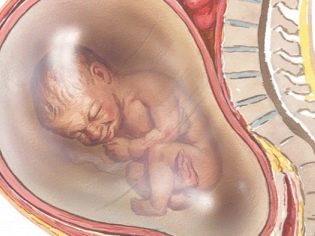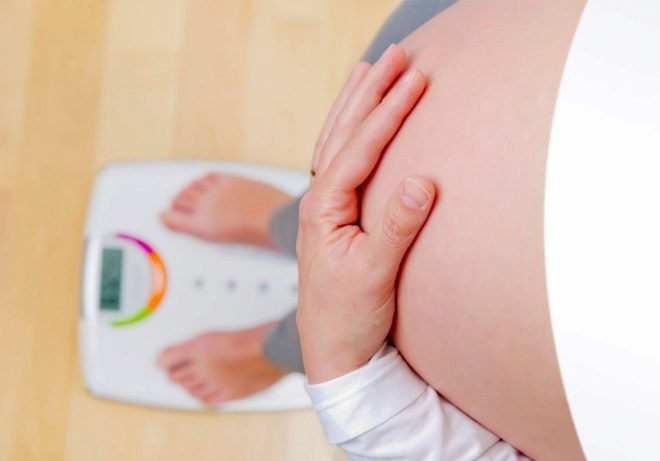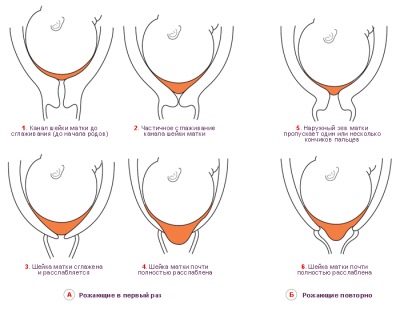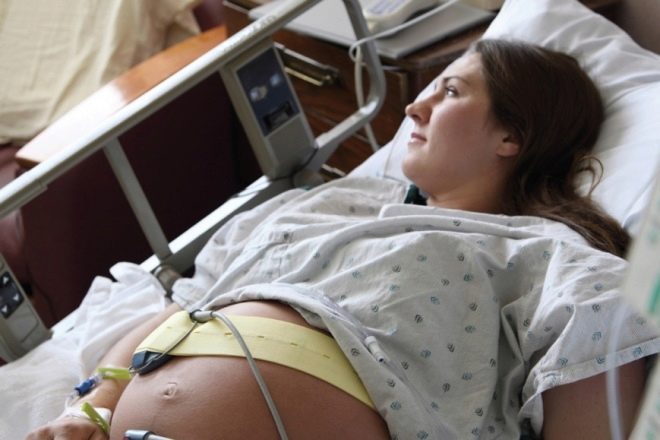What to do if childbirth does not begin at 40-41 week?
With the onset of 40 weeks of pregnancy, the woman literally "sits on the suitcase" - she is ready to go to the hospital at any minute, because things have already been collected, the documents have been checked. All relatives are in impatient anticipation. But the estimated date of birth passes, and the baby is in no hurry to be born.
Is this normal?
The estimated date of delivery (DA) exists in obstetric practice in order to approximate the timing of the completion of gestation. It is a calculus based on the last menstruation date. From her obstetricians, according to the established practice, take three months and add a week - this is how the approximate date is when the baby should be born.
Therefore, it is assumed that it is not 100% accurate. A woman’s ovulation could be delayed, come on later, and then the baby could well be born a week or two later. In addition, for the onset of labor, too many maternal and childish factors should coincide.
Regular labor activity begins when the organisms of the future mother and baby are fully prepared for this process. Hormonal background should be favorable, the uterus should be prepared, the cervix should soften, and the child should be mature enough to be born safely. This is so complex, multi-stage and individual process that it is impossible to estimate and calculate it by any obstetric formulas and mathematical calculations.
According to the existing medical statistics, concerning the period of occurrence of spontaneous reflex labor, exactly Only 5% of women give birth to a day.. This means that only about every twentieth pregnant woman can give birth at exactly 40 weeks of pregnancy, and this is not so much. Most of the physiological births occur in the week preceding it — 39–40 weeks. About 35% of children are born at 40-41 weeks, about 10% - after 41 weeks.
Therefore, deliveries in the week following the DA are not considered unusual or abnormal. Pregnancy at 40-41 weeks is not considered postponed - doctors do not see anything alarming in the fact that 40 weeks have passed, and childbirth has not yet begun. Just the time has not come yet. On the re-start start talking if the pregnancy lasts more than 42 weeks.
It should be noted that informing a child up to 40-42 weeks is more likely if the first birth is coming. In the second pregnancy and subsequent babies are usually born before the da. It is also unlikely that women with multiple pregnancies and polyhydramnios reach week 41.
If the time comes to give birth, and childbirth does not start at all, the main thing is not to worry and not to panic, so as not to harm the child and yourself. What is happening is a variant of the norm, there are no deviations in this phenomenon.
Precursors and their absence
Most women who are in the 41st week of pregnancy are frightened by the situation when there are no precursors of childbirth. From the point of view of physiology, such a situation is absolutely impossible. The body of a pregnant woman is actively preparing for this period; sometimes this preparation goes unnoticed., especially if the woman does not have a high degree of sensitivity.
Pregnant women are not always attentive to the signals of the body, and sometimes they simply do not know what they should be, so they conclude that the signs and symptoms of a fast birth simply do not occur.
Indeed, in some women the sensitivity of the nervous system is so low that specific markers of well-being before childbirth can be perceived by them somewhat smoothed out, almost imperceptibly. In addition, it is possible that there really are reasons for the lack of external manifestations of a large internal preparation of the body for childbirth.
The following are the main precursors and the reasons why they may not be observed.
Abdominal prolapse
The abdomen somewhat changes its shape and location, the height of standing of the uterus floor decreases due to the fact that the baby at a certain moment of its development, anticipating the imminent birth, moves to the lower part of the uterus, props up the internal pharynx. This pressure also stimulates the cervix - it starts to shorten faster and smoothed, slightly open.
After omission of the abdomen, a woman may feel some relief - there is no more pressure on the diaphragm., some internal organs are released, resulting in it becomes much easier and easier to breathe, reduced heartburn. However, this increases the pressure on the bladder. - there is a frequent need to empty it. A woman begins to visit the toilet for "little need" very often.
In most cases, in primiparous, the abdomen descends 3-4 weeks before giving birth, and those who give birth again descend a week, or even a few days. It is possible that the baby in repeated birth will take the position of "low start" only with the onset of labor contractions.
At 40-41 weeks, most women have such a sign, but there are exceptions. For example, in the pelvic position of the fetus or its oblique location in the uterine cavity omission does not occuras the presenting part is not the head. The stomach does not change the shape and height of standing in women who bear twins, in women with polyhydramnios, as well as with certain features of the structure of the pelvis.
Weight loss
Two weeks before giving birth, women usually notice that they began to weigh 2-3 kg less. Many people associate this with anxiety, feelings in the run-up to the generic process, and some believe that it is a matter of disturbing the appetite and eating less.
Really weight loss is a real harbinger, which suggests that the body becomes less intercellular fluid. Its reserves go as progesterone levels fall. The lower the level of this hormone, the faster the labor will begin. Also, the weight goes away due to a decrease in the amount of amniotic fluid.
Do not lose body weight in women with obesity, with a small fetus weight, according to ultrasound, with endocrine disorders.
Mucus plug
The exit from the cervical canal of the cervix of a mucous clot of a milky or yellowish color (sometimes with streaks of blood) is a sure sign of a speedy birth. The neck expands, softens. The mucus, which acts as a barrier against germs and viruses, cannot be kept inside and leaves the thin cervical canal. Normally, the discharge occurs either completely or in parts two weeks before the birth during the first pregnancy and a few days before the second birth. (jelly-like clots will be present in the secretions).
It should be borne in mind that the cork can go unnoticed, for example, when bathing in the bathroom or during sex. Also, the stopper can continue to be held in case of insufficient ripening of the cervix.
It is not excluded that it will not come out until the very moment of active contractions and then will go outside with the amniotic fluid. For this reason lack of characteristic discharge should not be considered the absence of a sign of approaching labor as such.
Cervical Maturity
Doctors will pay special attention to this symptom at 40–41 weeks. Mature is the neck, the length of which on this period is about one or less than one centimeter. It should be soft over the entire length, its location should be central.
If the deviation of the cervix is detected to the right, left, back or toward the front, or it will be softened unevenly or remain rigid, and also in the case when its length exceeds 1.5 centimeters, then this preparation will show the cervical drug uterus to childbirth.
Other symptoms
Harbingers, which consist in reducing the activity of the baby, in insomnia, diarrhea and other fairly subjective symptoms, can not directly indicate the approach of childbirth, so their absence should not worry a pregnant woman.
Feelings like thrusting a belt, tingling inside, backache, which women mention in thematic forums on the Internet, also can not be considered direct signs of imminent labor. They are more associated with fatigue and heaviness, because 41 weeks is a very impressive period for a pregnant woman to walk on very difficult.
It should be noted that the not always distinguishable presence of precursors means early delivery. It also happens that without any intelligible precursors a woman begins to give birth, and everything goes quite well.
Causes of deferred birth
Of course, a woman who has been carrying her baby for more than 40 weeks is most concerned about the question of why this is happening. Indeed, before the eyes of many examples - women give birth before 40 weeks, and here even the precursors are not observed.
The reasons can be quite a lot.
- Own biorhythm of the female body. As a rule, later childbirth begins in women who have a longer menstrual cycle (its duration is more than 30 days).
- Lack of physical activity. Women who move a little late, try to lie more or sit at rest, more often faced with a delay in the onset of labor. The fact is that adequate movement helps not only to prepare the muscles for childbirth, but also has a positive effect on the preparation of the cervix for the beginning of the reflex generic process.
- Large or giant fruit. A large child is called, the weight of which, according to the preliminary assessment of the ultrasound, is 40 weeks longer than 4 kg. Children are considered gigantic, and at the same period of gestation weigh about 5 kg.
- Psychological factor. That he should be given special importance. Sometimes it happens that a woman, not knowing herself in this clear report, postpones the moment of birth with her own fear of childbirth, unwillingness to experience pain, and sometimes unwillingness to give birth.
Childbirth can be delayed if the pregnancy is unwanted, the woman is in a difficult psychological situation, for example, she is experiencing significant financial problems or divorces her husband.
At the physical level, with the described experiences, there comes a muscular “blockade” - the woman is clamped, tense. The cervix, in consequence, is in no hurry to open. Stress hormones partially block sex hormones and the production of oxytocin.
The state of mother and baby
Future moms who have not started labor at the scheduled time are also worried about the condition of the child, because everyone has heard about the dangers of perenosheniya. But, as we have already found out, 40 and 41 weeks of gestation are not considered reparative, therefore the risks for crumbs are not as great as it may seem, if, of course, the pregnancy was uneventful and the state of crumbs is stable.
While the mother anxiously peers at the calendar and listens to herself in search of symptoms of imminent labor, the baby continues to gain weight in the womb. At 40-41 week he weighs more than 3.5 kg, and some - more than 4 kg. The growth of babies at this time usually exceeds 52 cm.
All organs and systems are developed and working. A sufficient amount of surfactant has accumulated in the lungs - a special substance that the alveoli produce. After the crumb takes its first breath, it is the surfactant that will not allow the alveolar vesicles to stick together as you exhale. This will allow the child to breathe freely from the first minutes after birth.
If mom is reassured, then below are some pediatric data.
- Children born as a result of prolonged gestation until 41 weeks of pregnancy, have a stronger immunity, are less likely to get sick.The placenta is old and does not fully fulfill its barrier function, so the baby in the womb receives more maternal antibodies in the last days than babies who are born before 40 weeks.
- After birth, children who have gained a good weight and a sufficient amount of subcutaneous fatty tissue, adapt the processes better and less often develop pathological situations of the early neonatal period.
The child became crowded. At week 41, the movements are minimal — they are limited only by necessity. For this reason, afraid that the crumb has become less active, not worth it. If there are no signs of hypoxia (and the doctors will check this for such a solid period of gestation), then the baby is completely comfortable and wonderful, which cannot be said about his mother.
Women by week 41 are exhausted: they ache, ache, and pull almost constantly and in almost any part of the body. The most common pain in the pubic joint. And it is at this time that hemorrhoids very often become acute.
There is less water, so any movement of the baby is perceived and felt almost painfully. Sleeping on your side becomes nauseous and unpleasant, and you cannot sleep in another pose - hence the sleep disorder.
Add hassle and training fights - they are intensified in those who experienced them throughout the third trimester, and may first appear in people who have not felt them before.
Doctors' actions
Since pregnancy at week 41 is not considered postponed, there is no point in waiting for active actions by doctors. They wait, observe, monitor the condition of the mother and the fetus.
If at this time a medical stimulation is offered and they do not explain why it is so urgently needed, then there is a reason to think about changing the attending physician or maternity hospital.
Induction of labor only on the basis that the DA was passed a few days ago is not considered reasonable and expedient - this is reflected in the clinical guidelines of the Russian Ministry of Health and the World Health Organization. Induction must be mandatory..
Births will be called in the maternity hospital at this time if the child is found to have the initial stages of a state disorder according to CTG. Also, stimulation is likely to occur when the amniotic fluid is leaking or is gradually dribbling.
Many testimonies for which a pregnant woman cannot be left alone, to wait for independent deliveries require operative delivery — a cesarean section (large or giant fetus with small pelvic dimensions, pronounced high water and other factors).
The decision on whether to stimulate childbirth, how the delivery will take place - independently or in the operating room with the help of surgeons, if there are no complications - is taken closer to 42 weeks gestation. At the hospital, you need to go to bed 40–41 weeks only for women who have pathologies that complicate the onset of labor. This is usually warned by an obstetrician-gynecologist in the antenatal clinic.
If the decision is made to stimulate labor at week 41, then they usually use the classical scheme:
- amniotomy (puncture of the fetal bladder);
- the introduction of "Oxytocin" and antispasmodics to relax the cervix after 3 hours, if no independent contractions have occurred after the puncture of the membranes of the fetal bladder.
For the stimulation of labor in the hospital, laminaria sticks can be used, which are inserted into the cervical canal for its mechanical expansion. Hormonal gels are used to prepare the cervix. With an immature neck, it is strictly prohibited to stimulate contractions with Oxytocin, Mifepristone and other drugs.
In the vast majority of cases, there is no need for stimulation this week.
A few decades ago, there was a pernicious practice in maternity hospitals of Russia - to stimulate childbirth in almost all cases when the date of birth indicated in the card was left behind.When we calculated and analyzed the indicators of child and female injuries during childbirth, as well as the increased number of emergency caesarean sections, we decided to abandon this practice at the state level.
Is it possible to cause contractions on their own?
If a child is in no hurry to be born, then he has certain reasons for that. The question of self-stimulation is rather dubious. It is clear that the woman is very tired to carry a heavy burden, but very little is left, so it would be more correct to wait for the contractions to begin on their own. Up to 42 weeks there is plenty of time.
In matters of self-stimulation of labor, traditional medicine has succeeded more than others. She prescribes women to drink a decoction of raspberry leaves, rosehips to bring birth closer. You can also have sex, if, of course, the mucus plug has not moved yet and there are no other contraindications.
Obstetricians recommend moving more, doing light gymnastics, and doing as much as possible the simple household chores that are not associated with excessive loads.
Reviews
According to women, the most effective way to bring birth at this time is sex. After a “productive” weekend spent with a spouse, many people will be sent to the maternity hospital within a day with full labor battles starting.
According to reviews of those who gave birth exactly at 41 weeks, the children did not show signs of deterioration, hypoxia, or distress.
Usually, women perceive a prolonged pregnancy for a prolonged pregnancy, therefore, in their responses, they are rather emotional.
An even and calm psychological state and a little patience are exactly what you need for this period.
More tips for pregnant women who have not yet given birth in week 41 will be found in the next video.




































